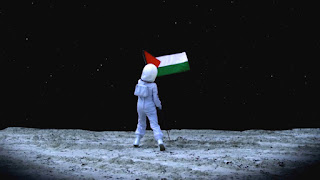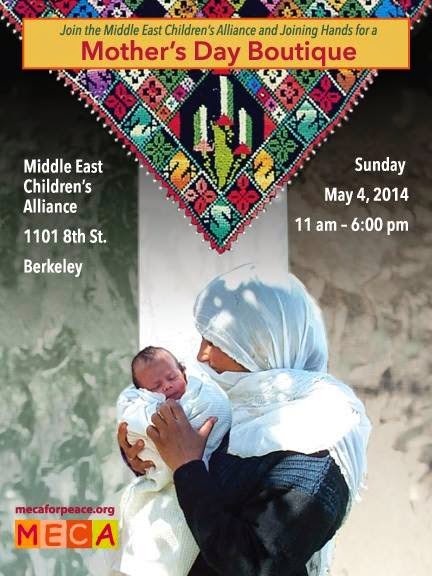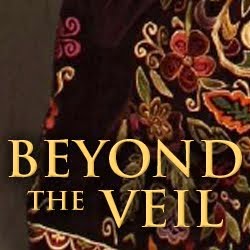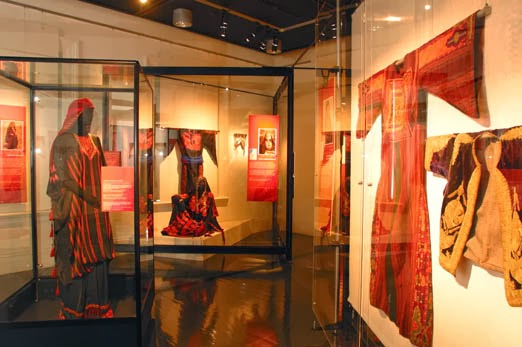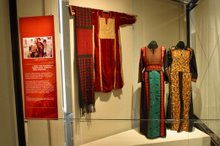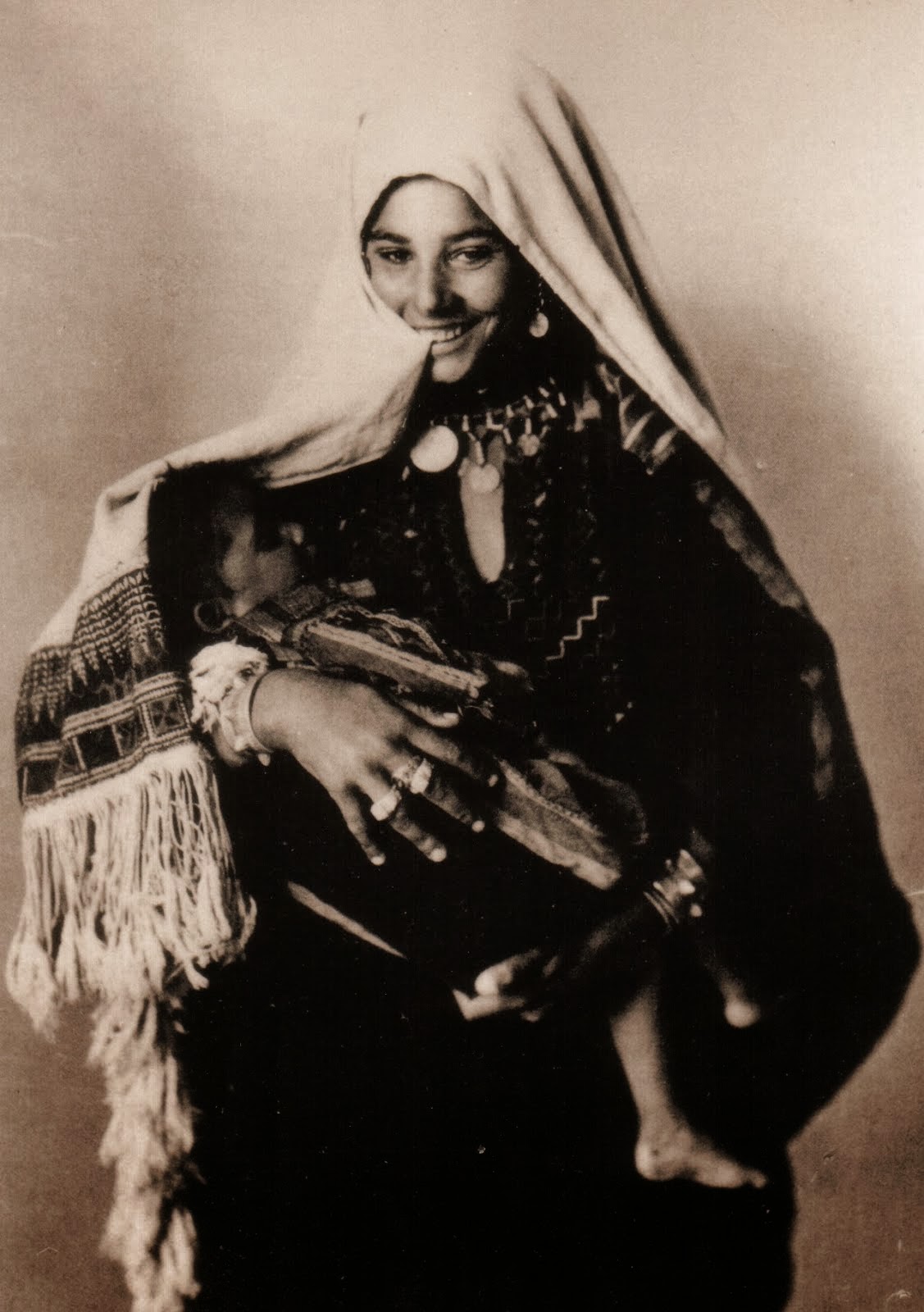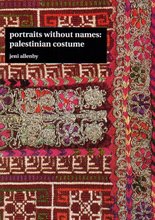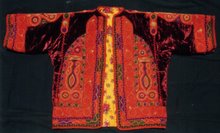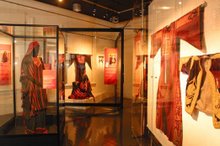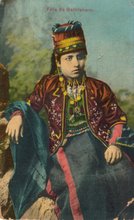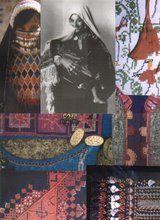 |
| Bedu thob - Sinai Desert, Egypt c. late 1960s-1970s Palestine Costume Archive collection Acquired Dec 2012 |
The former Canadian owner of this Sinai Desert bedu thob acquired it at a Sothebys' costume and textile auction in London during the 1980s. It came to the Archive's collection via Ebay in late 2012 after her unexpected death, with provenance details very kindly confirmed by her son.
 |
| Ebay photo courtesy the seller |
The thob is in excellent condition. We don't think it's been worn much since it passed through Sothebys' hands in the 1980s.
It's constructed in the traditional Sinai Desert bedu manner: made up of several different embroidered panels on black cotton sateen (dubayt or tubayt)) roughly stitched together.
It's a full length robe slightly flared from the waist, with short sleeves. This style became fashionable in the late 1960s and 1970s - you can see an example of the older fuller style thob with winged sleeves here at the Tareq Rajab Museum in Kuwait. The 1970s date is further confirmed by the brightly coloured floral and geometric patterns on the materials used for lining hems and around the neck:
 |
| Bedu thob - Sinai Desert, Egypt c. late 1960s-1970s Palestine Costume Archive collection Acquired Dec 2012 |
 |
| Bedu thob - Sinai Desert, Egypt c. late 1960s-1970s Palestine Costume Archive collection Acquired Dec 2012 |
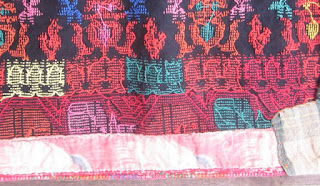 |
| Bedu thob - Sinai Desert, Egypt c. late 1960s-1970s Palestine Costume Archive collection Acquired Dec 2012 |
The thob is decorated with cross stitch embroidery. Traditionally DMC threads (introduced in the region in the mid-1930s) were used.
The qabbeh chest panel is small in size - a common feature of Sinai bedu dresses where the embroidery focus was on the lower back panel rather than the qabbeh, which was often concealed behind a burqa, as you can see in the 1960s garments below:
 |
| Sinai Desert bedu costumes in the Palestine Costume Archive's collection from traveling exhibition "Portraits without names: Palestinian costume" |
This garment's qabbeh is embroidered in solid patterns and bordered with red cotton fabric:
 |
| Bedu thob - Sinai Desert, Egypt c. late 1960s-1970s Palestine Costume Archive collection Acquired Dec 2012 |
In many cases a favored qabbeh is cut from an old garment and reattached to a new, which appears to have happened here, as the embroidery on the rest of the garment differs in design.
The sleeves are short and embroidered along the upper arm:
 |
| Bedu thob - Sinai Desert, Egypt c. late 1960s-1970s Palestine Costume Archive collection Acquired Dec 2012 |
 |
| Bedu thob - Sinai Desert, Egypt c. late 1960s-1970s Palestine Costume Archive collection Acquired Dec 2012 |
 |
| Bedu thob - Sinai Desert, Egypt c. late 1960s-1970s Palestine Costume Archive collection Acquired Dec 2012 |
Several type of hem stitch are present:
 |
| Bedu thob - Sinai Desert, Egypt c. late 1960s-1970s Palestine Costume Archive collection Acquired Dec 2012 |
 |
| Bedu thob - Sinai Desert, Egypt c. late 1960s-1970s Palestine Costume Archive collection Acquired Dec 2012 |
Embroidery is heavy on the skirt panels, which consist of separate pieces for the front, back and two side sections. The front panel includes geometrical designs as well as non traditional designs chosen from European pattern books.
 |
| Bedu thob - Sinai Desert, Egypt c. late 1960s-1970s Palestine Costume Archive collection Acquired Dec 2012 |
The complex and detailed back panel of a Sinai bedu thob is the most important, in terms of it's cultural language:
 |
| Bedu thob - Sinai Desert, Egypt c. late 1960s-1970s Palestine Costume Archive collection Acquired Dec 2012 |
If you compare the back panel of the new thob with the purely geometric back panel of a 1940s thob also in the Archive's collection, you can see the influence of European designs:
 |
| Back panel of a 1940s Sinai Desert bedu thob Palestine Costume Archive collection |
The new acquisition's back panel also contains these rabbits:
 |
| Bedu thob - Sinai Desert, Egypt c. late 1960s-1970s Palestine Costume Archive collection Acquired Dec 2012 |
although they are only on one side as the dress was obviously sold before the embroidery was finished.
 |
| Bedu thob - Sinai Desert, Egypt c. late 1960s-1970s Palestine Costume Archive collection Acquired Dec 2012 |
The inverted V designs at the top of the side panels are also incomplete:
 |
| Bedu thob - Sinai Desert, Egypt c. late 1960s-1970s Palestine Costume Archive collection Acquired Dec 2012 |
 |
| Bedu thob - Sinai Desert, Egypt c. late 1960s-1970s Palestine Costume Archive collection Acquired Dec 2012 |
One side contains human figures:
 |
| Bedu thob - Sinai Desert, Egypt c. late 1960s-1970s Palestine Costume Archive collection Acquired Dec 2012 |
Is the one on the left misplaced, or just incomplete?!
 |
| Bedu thob - Sinai Desert, Egypt c. late 1960s-1970s Palestine Costume Archive collection Acquired Dec 2012 |
Some embroidery close ups to finish:
 |
| Bedu thob - Sinai Desert, Egypt c. late 1960s-1970s Palestine Costume Archive collection Acquired Dec 2012 |
 |
| Bedu thob - Sinai Desert, Egypt c. late 1960s-1970s Palestine Costume Archive collection Acquired Dec 2012 |
 |
| Bedu thob - Sinai Desert, Egypt c. late 1960s-1970s Palestine Costume Archive collection Acquired Dec 2012 |
 |
| Bedu thob - Sinai Desert, Egypt c. late 1960s-1970s Palestine Costume Archive collection Acquired Dec 2012 |
We are really pleased to add this thob to the Archive's collection. We have quite a few Sinai Desert bedu outfits.
 |
| Sinai Desert bedu costumes in the Palestine Costume Archive's collection from traveling exhibition "Portraits without names: Palestinian costume" |
At the moment we exhibit them in two of our Palestinian costume touring exhibitions:
 |
| Sinai Desert bedu costume in the Palestine Costume Archive's collection from traveling exhibition "Portraits without names: Palestinian costume" |
as well as in "Secret Splendours: women's costume in the Arab world", as they relate to all the topics and are also very striking. We would like to curate an exhibition just on Sinai costumes because they really are quite extraordinary.
 |
| Sinai Desert bedu costumes in the Palestine Costume Archive's collection from traveling exhibition "Secret Splendours: women's costume in the Arab world" |
Especially when you see the whole outfit together.
 |
| Sinai Desert bedu costume in the Palestine Costume Archive's collection from traveling exhibition "Secret Splendours: women's costume in the Arab world" |
So hopefully you'll see our new acquisition on display in a traveling exhibition soon :)
 |
| Sinai Desert bedu and Siwa Oasis costumes in the Palestine Costume Archive's collection from traveling exhibition "Secret Splendours: women's costume in the Arab world" |




















